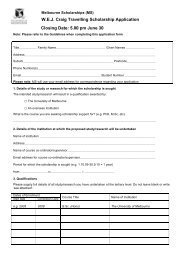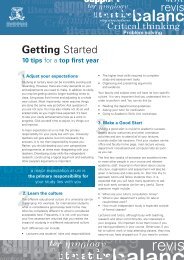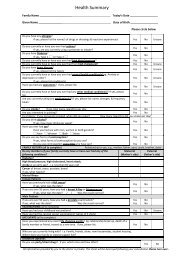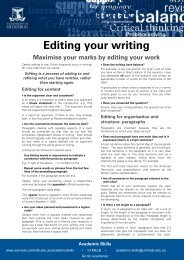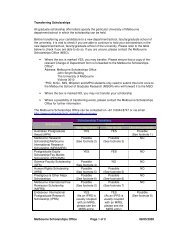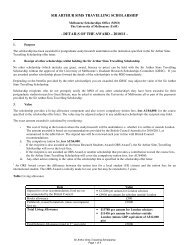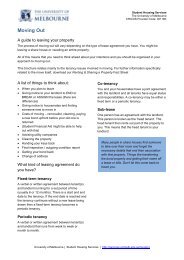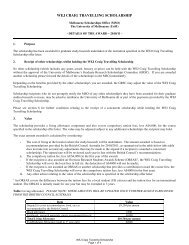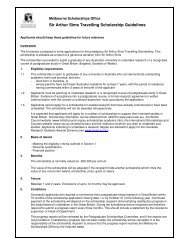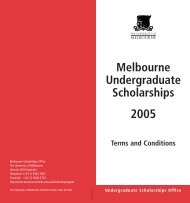Writing a Research Proposal - Student Services - University of ...
Writing a Research Proposal - Student Services - University of ...
Writing a Research Proposal - Student Services - University of ...
- No tags were found...
Create successful ePaper yourself
Turn your PDF publications into a flip-book with our unique Google optimized e-Paper software.
<strong>Writing</strong> a <strong>Research</strong> <strong>Proposal</strong>A guide for Science and Engineering studentsA <strong>Research</strong> <strong>Proposal</strong> has several inter-related purposes:<strong>Writing</strong> an effective research proposal also trains you in avaluable skill required to operate effectively in both1. Your proposed topic should address a significantproblem and, therefore, advance the state <strong>of</strong>knowledge in that field.2. You have identified an appropriate methodology andunderlying theory to address the problem, includingdata collection methods and equipment, if required.3. Your methods <strong>of</strong> data analysis are outlined andappropriate to your data set so that you can drawuseful conclusions from your work.4. You have an organised plan for your work, including atimeframe.academia and industry after you graduate. You arepresenting a reasonable thesis idea or hypothesis, thesignificance <strong>of</strong> which you have demonstrated by relating itto relevant literature in the field <strong>of</strong> enquiry. You are alsoproposing a methodology to investigate the problem withclear steps leading to a reasonable conclusion.The main criterion for the award <strong>of</strong> a PhD is that your thesisconstitutes an original contribution to knowledge in aparticular field. Remember that you may eventually refine oreven abandon your initial topic as your research progresses,but the proposal demonstrates that you are aware <strong>of</strong> theprocess <strong>of</strong> enquiry and experimentation that leads to athesis outcome.Finally, the research questions, significance andmethodology that you write in your <strong>Research</strong> <strong>Proposal</strong> willhelp you refine your Themis ethics research application.The structure <strong>of</strong> a thesis proposalThe structure and size <strong>of</strong> your <strong>Research</strong> <strong>Proposal</strong> will varydepending the requirements <strong>of</strong> your Faculty or School sothe initial step is to find out departmental guidelines andrequirements. Nevertheless, there are certain elementsthat any <strong>Research</strong> <strong>Proposal</strong> requires and these should bepresented in the following order.Title or Cover Page: identifies the research project title,the student researcher, the institution, department, and theproject mentors or supervisors.The title should be brief and descriptive and may use acolon (:) to separate the topic from the focus (e.g.Stormwater Harvesting: managing the hazards <strong>of</strong> surfacewater pollution by run-<strong>of</strong>f).Table <strong>of</strong> Contents: lists the sections <strong>of</strong> the <strong>Research</strong><strong>Proposal</strong> (headings and indented sub-headings) and thecorresponding page numbers.Abstract: outlines the essence <strong>of</strong> the research project inaround 150–200 words. It describes the purpose andmotivation for the study, and a statement <strong>of</strong> the problem,Academic Skillsthe data collection methodology and analysis, and thesignificant results and implications <strong>of</strong> the research.Introduction: provides background information for theresearch (i.e. the problem being addressed) and is typicallystructured from general information to narrow or focusedideas; whereupon your research question/s or hypothesesare presented.The Introduction should be about 10% <strong>of</strong> your proposal.Imagine you are writing for a general science reader ratherthan an expert audience.The Introduction includes a brief review <strong>of</strong> relevantliterature or knowledge in the field, so that you are able topresent the gap in the existing knowledge and, therefore,the significance and originality – the purpose and aims – <strong>of</strong>your research.Finally, articulate the scope <strong>of</strong> your research; or what youwill not be doing, so as to limit your task.<strong>Research</strong> Question/s: what is the primary question you aretrying to solve? It may be a hypothesis/hypotheses orresearch question/s and is usually a few sentences (instatement and/or question form) that articulate the essence<strong>of</strong> your project and its scope. E.g. Land use and terrestrialcarbon storage in western Victoria from 1890-2020: Ahistorical reconstruction and simulation study.<strong>Research</strong> Design or Methodology: includes a descriptionand rationale for the methods <strong>of</strong> data collection andanalysis, and the materials used when solving the problem.When and how will you know, for example, that sufficientexperimentation has been done, and sufficient and validdata analysed, to support or invalidate the originalhypothesis?This section includes the dataset/s, calculations, equipment,calibration graphs, and procedures to be used, lists projectlimitations and outlines how ethical considerations <strong>of</strong> theresearch have been considered.Typically, it uses subheadings (i.e. Subjects,Instrumentation, Data Collection, Methods <strong>of</strong> Analysis etc.)and is written with a future aspect, e.g. The research willinitially examine water treatment processes in...Preliminary Results: details any results that you mayalready have as a result <strong>of</strong> previous Honours or Mastersresearch work, perhaps also from a pilot study. It isimportant to relate these results to the critical framework <strong>of</strong>your intended PhD research.Timetable / Plan: lists the stages <strong>of</strong> the research project intimeline, spreadsheet or tabular format, and the deadlinesfor completion <strong>of</strong> these stages or tasks. You should includeany challenges to completion that you anticipate facing.Thesis Outline or Structure: outlines the proposedchapters <strong>of</strong> the thesis and the content <strong>of</strong> each chapter inseveral lines or a paragraph, including a Table <strong>of</strong> Contents.www.services.unimelb.edu.au/academicskills • 13 MELB • academic-skills@unimelb.edu.auGo for excellence



